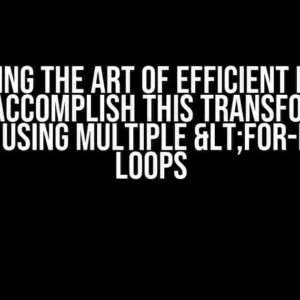Welcome to this article, where we’ll dive into the mysterious world of PowerShell and explore one of its most intriguing behaviors: how the Select-Object cmdlet’s ExpandProperty parameter changes the source object. Yes, you read that right – changes the source object!
What is ExpandProperty, anyway?
Before we dive into the why, let’s quickly cover the what. The ExpandProperty parameter is a part of the Select-Object cmdlet, which is used to select specific properties from objects in PowerShell. When you use ExpandProperty, you’re telling PowerShell to retrieve the value of a specific property and return it as a new object.
Get-Process | Select-Object -ExpandProperty NameIn this example, we’re using Get-Process to retrieve a list of processes, and then selecting only the Name property using Select-Object. The -ExpandProperty parameter tells PowerShell to return the value of the Name property as a new object.
The mystery of the changing source object
Now, here’s where things get interesting. When you use ExpandProperty, you might expect that the original object remains unchanged. After all, you’re only selecting a specific property, right? Well, not exactly.
It turns out that when you use ExpandProperty, PowerShell actually modifies the original object. Yes, you read that right – modifies the original object!
$processes = Get-Process
$processes | Select-Object -ExpandProperty Name
$processesIn this example, we first retrieve a list of processes using Get-Process and store it in the $processes variable. Then, we use Select-Object with -ExpandProperty to select only the Name property. Finally, we print the contents of the $processes variable again.
What do you think happens? Do you think the $processes variable still contains the original list of processes? Think again!
| Before ExpandProperty | After ExpandProperty |
|---|---|
|
|
As you can see, the original list of processes is now replaced with a list of process names! This is because ExpandProperty modified the original object, replacing it with a new object containing only the selected property.
Why does this happen?
So, why does PowerShell behave in this way? The answer lies in the way PowerShell handles objects and piping.
In PowerShell, when you pipe objects to a cmdlet, the objects are not passed by value, but rather by reference. This means that the cmdlet receives a reference to the original object, rather than a copy of the object.
When you use ExpandProperty, PowerShell modifies the original object by replacing it with a new object containing only the selected property. This is because the Select-Object cmdlet is designed to work on the pipeline, modifying the objects as they pass through.
How to avoid the side effects
So, how can you avoid this unexpected behavior? There are a few ways to do so:
-
Use the
-NoExpandparameterYou can use the
-NoExpandparameter withSelect-Objectto prevent the original object from being modified.$processes | Select-Object -ExpandProperty Name -NoExpand -
Use a new variable
Instead of modifying the original object, you can store the result of the
Select-Objectcmdlet in a new variable.$processNames = $processes | Select-Object -ExpandProperty Name -
Use the
Foreach-ObjectcmdletYou can use the
Foreach-Objectcmdlet to iterate over the objects and extract the desired property without modifying the original object.$processes | Foreach-Object {$_.Name}
Conclusion
In conclusion, the ExpandProperty parameter of the Select-Object cmdlet can have unexpected side effects, modifying the original object in the process. By understanding how PowerShell handles objects and piping, you can avoid these side effects and use ExpandProperty with confidence.
Remember, when working with PowerShell, it’s essential to understand the underlying mechanics of the language to avoid unexpected behavior and ensure your scripts run smoothly.
Thanks for joining me on this journey into the world of PowerShell! If you have any questions or feedback, feel free to leave a comment below.
Stay PowerShell-ful, my friends!
Frequently Asked Question
Get ready to unleash the power of PowerShell and unravel the mystery of ExpandProperty!
What is the ExpandProperty cmdlet and why does it modify the source object?
The ExpandProperty cmdlet is used to select properties from an object, but it doesn’t just return the value of those properties – it also modifies the original object! This is because ExpandProperty uses the `Select-Object` cmdlet under the hood, which returns a new custom object with the selected properties. When you assign this new object to a variable, it overwrites the original object, effectively modifying it.
Why does ExpandProperty modify the source object, and not just return a new one?
The reason ExpandProperty modifies the source object is due to the way PowerShell handles objects. When you pipe an object to a cmdlet, PowerShell passes a reference to the original object, not a copy of it. This means that any modifications made to the object by the cmdlet, such as selecting new properties, affect the original object.
How can I avoid modifying the source object when using ExpandProperty?
To avoid modifying the source object, simply assign the result of ExpandProperty to a new variable, like so: `$newObject = $originalObject | Select-Object -ExpandProperty MyProperty`. This way, you create a new object with the selected properties, leaving the original object intact.
What are some scenarios where ExpandProperty’s behavior can be problematic?
Be cautious when using ExpandProperty in scenarios where the original object is used later in the script or is part of a larger data structure. Modifying the original object can lead to unexpected behavior or data corruption. For example, if you’re using ExpandProperty on an array of objects and then trying to access the original array later, you might be surprised to find that the objects have changed!
Are there any alternatives to ExpandProperty that don’t modify the source object?
Yes, you can use the `Select-Object` cmdlet with the `-Property` parameter instead of `-ExpandProperty`. This will return a new object with the selected properties, without modifying the original object. For example: `$newObject = $originalObject | Select-Object -Property MyProperty`. This approach is often a safer and more predictable way to work with objects in PowerShell.


